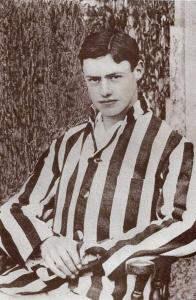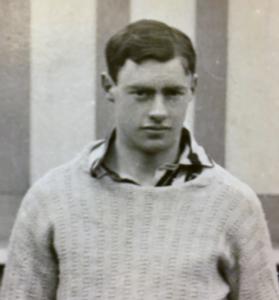
|

|
| Lieutenant Harold Walter WADE | |
|
3rd Brahman Regiment attached to No. 1 Company, 9th Battalion Bhopal Infantry, Indian Army Date of birth: 7th January 1888 Date of death: 29th November 1914 Killed in action aged 26 Commemorated on the Menin Gate Panel 1 |

|
| Harold Walter Wade was born at Henfield on the 7th of January 1888 the youngest but one of the six sons of Charles Aubrey Wade, a solicitor, and Sarah (nee Crouch) Wade of "The Croft House", Henfield in Sussex. He was educated at Merton House School, Southwick and at Lancing College where he won an Exhibition and was in News House from September 1902 to July 1907. He was a Sergeant in the Officer Training Corps, a member of the Cricket XI in 1906 and 1907 and was appointed as a Prefect in 1906. He won a Classical Scholarship to Keble College Oxford which he entered in October 1907. He was a member of the College Football XI from 1907 to 1911 and of the Cricket XI from 1908 to 1911, being Captain in 1911. He played for the Hockey XI from 1908 to 1911. He was elected as the President of the Junior Common Room in 1910 and was a member of the Debating Society in the same year. He was a member of the Oxford University Officer Training Corps. He achieved 2nd Class Classical Moderations in 1909 and 2nd Lit. Hum. in 1910. He played cricket and football regularly for the OLs. He was commissioned as a 2nd Lieutenant on the Unattached List for the Territorial Force on the 25th of November 1911. He was attached to the 3rd Brahman Regiment on the 23rd of March 1913 and was promoted to Lieutenant on the 17th of April 1913. By late October 1914 the 9th Bhopal Infantry were in reserve positions near Neuve Chappelle. On the 26th of October the enemy advanced under cover of the Bois du Biez and attacked the village and, after fierce fighting, they gained part of the north eastern side of the village. The following day a counter attack was mounted to eject them from their foothold but in spite of hand to hand fighting they held on to their early gains though most of the day. At dusk a determined British counterattack managed to regain most of the lost ground but, heavily reinforced, the Germans themselves mounted a counterattack and, through sheer weight of numbers, managed to capture the entire village and drive a salient into the British lines. As darkness fell urgent messages came back from the beleaguered defenders to the effect that unless they were reinforced the line could be broken. At 5pm the 9th Bhopal Infantry received orders to counterattack in the direction of Pont Logy in an attempt to attack the enemy in the flank and to relieve the pressure on a battalion of the Royal West Kent Regiment. They crossed the countryside in the dark where they were hampered by boggy ground and barbed wire before reaching the West Kent’s position. They soon became involved in fighting around a small hamlet to the south of Neuve Chappelle where No. 1 Company, under the command of Major L.J. Jones and Harold Wade, killed around thirty of the enemy. At 10.30am on the morning of the 28th of October 1914 the British artillery opened a barrage on the German positions which lasted for half an hour before part of the battalion along with the 47th Sikhs and the 20th and 21st Companies from the Sappers and Miners attacked. They covered the 700 yards to the enemy positions in a series of short rushes and when they were within 100 yards of the German trenches the enemy began to fall back under the threat of Indian bayonets. They were pursued into the streets of the village where further hand to hand fighting took place. As they reached the cross roads at the centre of the village the men came under heavy fire from a well sited machine gun Casualties on both sides were very heavy as both sides attacked and counterattacked with the Germans using the bodies of their dead as cover from repeated Indian onslaughts. As the Indian troops were being rallied for a final charge the Germans attacked once again in overwhelming numbers which forced the Indians to fall back from the village and across 500 yards of shell swept ground under a “tornado” of fire. By the time they reached the comparative safety of the La Bassee Road only sixty eight of the two hundred and eighty nine men who had gone into the action remained. The survivors were marched to Rouge Croix where they went into billets. Casualties for the action had been one Indian officer and Major Jones killed, Harold Wade was wounded and missing with one other officer wounded, one officer was taken prisoner and two hundred and sixty two other ranks were killed wounded or missing. The Officer Commanding his Regiment wrote:- "It was my privilege to know him well; a more high minded and zealous man and officer would be difficult to find." The Commanding Officer of 9th Brigade wrote:- "I applied personally to the Commander in Chief in India to have him appointed to my regiment. He was a fine, keen young officer and truly liked by all, British and Indian alike." He is commemorated on the war memorial at Henfield and on the memorial at Keble College Oxford. |
|
 | |
| News House |
Back